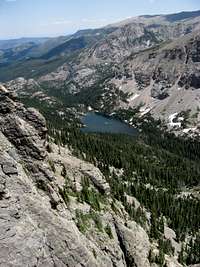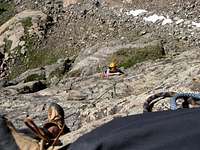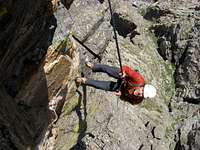-
 11944 Hits
11944 Hits
-
 83.69% Score
83.69% Score
-
 17 Votes
17 Votes
|
|
Route |
|---|---|
|
|
Mountaineering, Trad Climbing |
|
|
Summer, Fall |
|
|
A long day |
|
|
5.8 (YDS) |
|
|
7 |
|
|
III |
|
|
Overview
The Zowie Tower is an amazing and stunning pinnicle on the side of Otis. Zowie is a tiny 'fin' of rock seen to the South when approaching other classic climbs like the Petit Grepon and Sharkstooth. Rock quaity is amazing and the moderate climbing along with a gorgeous summit make this climb a classic in my opinion.Getting There
To get here, park at the Glacier Gorge Junction one mile before the Bear Lake parking lot. Take the trail to Alberta Falls, and keep going, (you can use the fireman's trail to shave off a little time.) Contiune past the Loch for a mile and then cross a footbridge and go south heading up towards Andrews Glacier. Once you come into the open, start looking to the right and you'll see obvious towers. Wham is the other tower to the right of Zowie.Take the path of least resistance to the base of the climb.
The South Face is the standard route on this tower and has great rock quality. It is often compared to the Petit Grepon. With a much shorter approach and a beautiful summit, this is a worthy tick on any climbers list.
Route Description
Pitch 1-2: We combined the first two pitches with a 70m rope. We started immediately right of a small right-facing dihedral. The start is a little tricky and pro is decent, the climbing felt 5.8 to me. Apparently there is an easier start to the west of the standard start that is rated at 5.4, but I think that the direct start is fun and challenging. After the start section, the climbing becomes easier with good places to rest. Protection seemed run-out here, but the climbing is easy. Rope drag can become an issue here since the route has no set course and you follow the most interesting line or the easiest path, so remember to use long runners. Either way, climb until you get to a big ledge that nearly spans the entire south face of the spire.Pitch 3: Traverse the large ledge to set up a belay to the east. We simul climbed this section and felt comfortable with it, but if you are not comfortable with exposure, rope up and be safe. There are a few cracks, but there is a large ledge just below a prominent left-facing dihedral. The dihedral has several good places for pro and is very enjoyable. Other than the last pitch, this is most definately the best climbing on the tower. Head up the dihedral and up the obvious crack system quite a ways and belay on a good ledge. According to many guidebooks, this is 5.6, however I felt the technqiue needed was more in the 5.7+ range.
Pitch 4-5: We also combined these next two pitches with a 70m rope, although I feel it would be possible with a 60m as well. There seems to be large amount of crack systems, and the guide does not recomend any particular one. Just pick out a line that looks fun and well-protectable and go up. I remember seeing chalk occasionally, and this helps to keep you on path as well. After a short section, the terrain gets lower-angled. Pick the easiest line and continue working to the right (east) side of the base of the summit tower. Find and set up a good bely on a ledge or continue on to string the next pitch together. Make sure you do not have excessive rope drag that will cause the rope to wear down on rocks and gear and make climbing for the leader difficult! The next pitch (5th) climbs cracks on the east side of the spire. Continue moving east and shoot for the base of the tower. Set up a belay on a good ledge when you can find one. From here the south face of the climb is not quite visable. Both pitches are fun and felt like 5.6.
Pitch 6: This is a very short traverse pitch that moves along the base of the summit tower from east to west. In the Rossiter guidebook this is combined with the pitch 5, however we did this one separate and combined pitches 4-5. It takes you to the base of the final pitch which is marked by two large cracks, almost to the edge of the southwest arete where you can look around and see the drop-off of the north face. Climbing felt 5.6.
Pitch 7: This is the icing on the cake. There is a great belay ledge and you are in sight of your belayer the entire time. This and the summit are the reasons that Zowie should be considered a classic. There are two cracks, avoid the large off-width if possible and move the the finger and hand sized crack to the left. There is excellent exposure and good protection, (some older and newer pitons to clip into, almost like sport climbing!) The guide calls this a 5.8+ thin crack/face, however I felt this was stout for the grade. The trick at the crux (5.8+) bulge is to stay left of the crack and reach high. There are large jugs everywhere and good footwork will help you reach the needed hols and keep you from getting pumped. After this you are pretty much on the summit! Enjoy the view and weather with your partner before rapping. The shrp peak to the north is the Sharkstooth.
To descend use the anchors to either rap off north or west. Make sure your runners go over the ledge if you choose to rap on the west side since the rope WILL get snagged on the rock and make pulling it impossible. We found this out the hard way and had to ascend the rope with an ATC and a prussick to fix the probelm. Most people rap off the north side and then head west down the gully on the west side of the spire, however the other rappel is much steeper and fun in my opinion. Two 60m ropes will easily get you to the grassy gully below. Hike carefully down the gully and find the final set of beefy anchors for the short (40 ft or so) rappel near the bottom of the gully. After that, all you have to do is navigate through some talus and scree and you are back where you started.
Essential Gear
A standard rack is all that is recomended for this climb, but this is a list of what I brought, and I used every single piece. If you choose to string pitches together, having doubles or even triples is helpful.BD Camalot 0.1 & 0.2
BD Camalot 0.5-3 (with doubles on the #2-3)
Blue-Yellow Alien Cams
Blue and Black Metolius PowerCam
Blue Metolius TCU
Full set of nuts
Full set of Rockcentrics
As always, bring a helmet and make sure to bring plenty of water if it is a warm summer day. And as always, be safe and have fun!












brandon - Jul 22, 2007 2:00 pm - Hasn't voted
Summit pitchesHey yal, I believe there are 4 summit variations. The face Dan climbed on has two. Both old aid routes. The 'real' finishes are on the face around the corner to the left. At the very far left of that face is a 5.8+++ squeeze and offwidth over a roof formed by a detached pillar. Burly and ledge fall potential if you don't have 7 to 10 inch gear. In the center of that face is a killer 5.9 finger crack with jugs that looks like it would be 10+. You must traverse 50 or so feet left to reach these from the typical belay bellow. Seems most people climb 20 or 30 feet too high from the belay, look left and realize they can't traverse any more, and finish up that crappy, bulgy, facey crack thing with all the fixed pins.
Dan Dalton - Jul 23, 2007 10:38 am - Hasn't voted
Re: Summit pitchesThat is good info to know, thanks for the heads up. I definately went on the bugly fixed pin line, but I felt that I got some finger-crack and jug action as well. I definately saw the off-width and immediately opted for something different. Thanks for the additon/correction. Dan
JonW - Aug 13, 2013 4:55 pm - Hasn't voted
South Face, Summit PitchBrandon's comment is correct, the two "standard" finishes are on the south face of summit tower. We opted for the figure crack, which is several feet right of the off-width. This is not 5.9. I found it no harder than 5.8 with plenty of jugs and bomber gear. There aren't any pins on this variation.